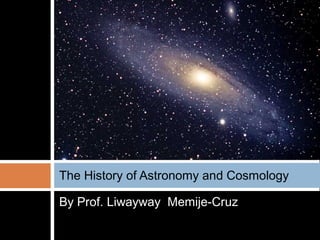
History of Astronomy
- 1. By Prof. Liwayway Memije-Cruz The History of Astronomy and Cosmology
- 2. Astronomy the science of the entire universe beyond the Earth. studies the motions and nature of celestial bodies. includes the Earth’s gross physical properties: its mass and rotation, as they interact with other bodies of the solar system. includes the Sun, Moon, planets and comets. stars, galaxies, nebula, and the
- 3. Celestial mechanics the science of the motion of planets and other solid objects within the solar system. became the first testing ground for Newton’s laws of motion and helped in establishing the fundamental principles of classical physics.
- 4. Astrophysics the study of the physical properties and the determination of the chemical composition of celestial bodies.
- 5. Cosmology the study of the universe as a whole, including its distant past and its future. studies the universe through observations by looking at the universe; and theoretically through using physical laws and theories to predict how the universe should behave. involves a wide range of other sciences, such as physics and chemistry. the study of the origin of the solar system.
- 6. About 350 B.C., Aristotle, A Greek philospher proposed a cosmology that was held for thousands of years. theorized that the Sun, the Moon and the planets all revolved around the Earth on a set of celestial spheres.
- 7. Aristotle: celestial spheres were made up of q uinte sse nce , which is a perfect, unchanging, transparent element. outermost sphere was made of stars, which appeared to be fixed in position. Early astronomers called them “fixe d stars ” to differentiate them from planets. The spheres inside the spheres of the fixed stars held the planets which astronomers called them “wande ring stars ”.
- 8. About 5250 B.C.: Greek astronomer, Aristarchus of Samos: first known astronomer to assert that the Earth moved around the Sun, but Aristotle’s model of the universe prevailed and was accepted for almost 1,800 years after his assertion.
- 9. Ptolemy, Greek scientist explained the retrograde motion as the result of a set of small circles, called e picycle s, on which the planets moved. hypothesized that the epicycles moved on larger circles called de fe re nts and the combination of these motions caused the dominant forward motion and the occasional retrograde loops.
- 10. Nicolaus Copernicus, Polish astronomer developed the model of a Sun-centered universe. explained the daily and yearly motion of the sun and stars in the universe
- 11. Tycho Brahe, Danish astronomer made the most scientific and accurate observation of the universe. discovered discrepancies between astronomical predictions and the actual events. built a set of large instruments that allowed him to record the positions of the planets and stars with unprecedented accuracy.
- 12. Johannes Kepler, German astronomer discovered that the planets orbited around the sun in ellipses or elongated circles with the sun a bit off-center at one focus.
- 13. Galileo Galilei, the first astronomer to use a telescope to observe and recognize everything he saw in the sky. found out that the Moon had craters, that Venus went through a full set of phases like the moon and that Jupiter had satellites, or moons of its own.
- 14. Isaac Newton derived a wide range of theoretical results about planetary orbits and advanced the law of universal gravity. Newton’s laws were accepted as the foundation of cosmological field until the 20th
- 15. Why is The Night Sky Black?
- 16. Olber’s paradox by Heinrich Olbers why the sky was dark at night if space is indeed infinite why the stars are distributed throughout that infinite space. an infinite amount of starlight make the sky very bright at night.
- 17. Henrietta Leavitt relates distance to variations in brightness of Cepheid variables, a class of stars that vary periodically in brightness. Known for period- luminosity of Cepheid stars
- 18. Harlow Shapley measured the distance of several groups of stars known as globular clusters. His observations made the cosmologists realized that the Earth and the Sun do not occupy any special position in the universe.
- 19. Globular Cluster Orbit showed that the clusters were centered around a point far from the sun and the arrangement of the clusters was presumed to reflect the overall shape of the galaxy, thus realized that the sun was not the center of the galaxy.
- 20. Edwin Hubble o Showed that the universe is expanding o Known for the Hubble Law that the uniform relationship between velocity of expansion and the distance from the Earth. o The redshifts are not true Doppler shift but rather the result from the expansion of space which carries the galaxies along with it.
